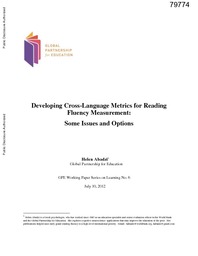
ATTENTION: The works hosted here are being migrated to a new repository that will consolidate resources, improve discoverability, and better show UTA's research impact on the global community. We will update authors as the migration progresses. Please see MavMatrix for more information.
Show simple item record
| dc.contributor.author | Abadzi, Helen | |
| dc.date.accessioned | 2014-07-03T22:33:40Z | |
| dc.date.available | 2014-07-03T22:33:40Z | |
| dc.date.issued | 2012 | |
| dc.identifier.citation | Abadzi, Helen. 2012. Developing cross-language metrics for reading fluency measurement : some issues and options. Global Partnership for Education (GPE) working paper series on learning ; no. 6. Washington DC : World Bank. http://documents.worldbank.org/curated/en/2012/07/18042889/developing-cross-language-metrics-reading-fluency-measurement-some-issues-options | en_US |
| dc.identifier.uri | http://hdl.handle.net/10106/24345 | |
| dc.description | Global Partnership for Education | en_US |
| dc.description.abstract | Since 2005, over 70 oral reading fluency tests have been given in many languages and scripts, either as part of the Early Grade Reading Assessment (EGRA) or as individual one-minute tests. Particularly in multilingual countries, reading speed and comprehension measures have been taken in multiple languages and also in multiple scripts. The development of language has a significant genetic component, which tends to create common grammatical structures. Then languages must conform to information processing limitations, notably to working memory capacity. On the basis of such features, it may be possible to develop common standards for performance improvement compare findings cross linguistically. Languages are most comparable when large chunks are used rather than single words. To arrive at some comparisons, several methods may be tried. These include: a) counting actual words in connected texts or in lists, using some conventions if needed; b) using computational solutions to arrive at coefficients of certain languages vis a vis others, such as 1 Swahili word being equivalent roughly to 1.3 English words; c) using in multiple languages lists of words of a defined length, e.g. 4 letters; d) measuring phonemes or syllables per minute, possibly dividing by average word length; and e) rapid serial visual presentation, potentially also measuring perception at the letter feature level. Overall, reading rate as words per minute seems to be a valid and reliable indicator of achievement, with 45-60 words being a range that is usable as a benchmark. | en_US |
| dc.language.iso | en_US | en_US |
| dc.publisher | World Bank | en_US |
| dc.relation.ispartofseries | Global Partnership for Education (GPE) working paper series on learning;no 6 | |
| dc.relation.ispartofseries | GPE Working Paper Series on Learning No. 6 | en_US |
| dc.subject | Achievement tests | en_US |
| dc.subject | Reading competence | en_US |
| dc.subject | Reading teachers | en_US |
| dc.subject | Literacy | en_US |
| dc.subject | Illiteracy | en_US |
| dc.subject | Primary education | en_US |
| dc.subject | Learning assessments | en_US |
| dc.subject | Educational measurement | en_US |
| dc.subject | Child development | en_US |
| dc.subject | Linguistics | en_US |
| dc.subject | Cognitive sciences | en_US |
| dc.title | Developing cross language metrics for reading fluency measurement: Some issues and options | en_US |
| dc.type | Working Paper | en_US |
| dc.publisher.department | Department of Curriculum and Instruction, The University of Texas at Arlington | en_US |
| dc.identifier.externalLink | http://documents.worldbank.org/curated/en/2012/07/18042889/developing-cross-language-metrics-reading-fluency-measurement-some-issues-options | en_US |
| dc.identifier.externalLinkDescription | http://uta.academia.edu/HelenAbadzi | |
Files in this item
- Name:
- developing cross language.pdf
- Size:
- 1.359Mb
- Format:
- PDF
- Description:
- PDF
This item appears in the following Collection(s)
Show simple item record


